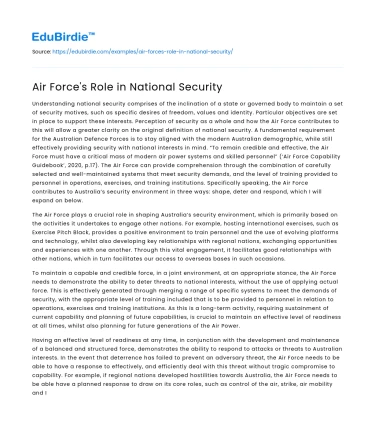Understanding national security comprises of the inclination of a state or governed body to maintain a set of security motives, such as specific desires of freedom, values and identity. Particular objectives are set in place to support these interests. Perception of security as a whole and how the Air Force contributes to this will allow a greater clarity on the original definition of national security. A fundamental requirement for the Australian Defence Forces is to stay aligned with the modern Australian demographic, while still effectively providing security with national interests in mind. “To remain credible and effective, the Air Force must have a critical mass of modern air power systems and skilled personnel” (‘Air Force Capability Guidebook’, 2020, p.17). The Air Force can provide comprehension through the combination of carefully selected and well-maintained systems that meet security demands, and the level of training provided to personnel in operations, exercises, and training institutions. Specifically speaking, the Air Force contributes to Australia’s security environment in three ways: shape, deter and respond, which I will expand on below.
The Air Force plays a crucial role in shaping Australia’s security environment, which is primarily based on the activities it undertakes to engage other nations. For example, hosting international exercises, such as Exercise Pitch Black, provides a positive environment to train personnel and the use of evolving platforms and technology, whilst also developing key relationships with regional nations, exchanging opportunities and experiences with one another. Through this vital engagement, it facilitates good relationships with other nations, which in turn facilitates our access to overseas bases in such occasions.
Save your time!
We can take care of your essay
- Proper editing and formatting
- Free revision, title page, and bibliography
- Flexible prices and money-back guarantee
To maintain a capable and credible force, in a joint environment, at an appropriate stance, the Air Force needs to demonstrate the ability to deter threats to national interests, without the use of applying actual force. This is effectively generated through merging a range of specific systems to meet the demands of security, with the appropriate level of training included that is to be provided to personnel in relation to operations, exercises and training institutions. As this is a long-term activity, requiring sustainment of current capability and planning of future capabilities, is crucial to maintain an effective level of readiness at all times, whilst also planning for future generations of the Air Power.
Having an effective level of readiness at any time, in conjunction with the development and maintenance of a balanced and structured force, demonstrates the ability to respond to attacks or threats to Australian interests. In the event that deterrence has failed to prevent an adversary threat, the Air Force needs to be able to have a response to effectively, and efficiently deal with this threat without tragic compromise to capability. For example, if regional nations developed hostilities towards Australia, the Air Force needs to be able have a planned response to draw on its core roles, such as control of the air, strike, air mobility and ISR to provide effective support in a joint environment to properly manage and monitor the threat.
In summary, the role of the Air Force in a national security environment is driven by the national security strategy, the enduring roles of the Air Power, and the level of capability available to execute these functions; therefore, the Air Force must have the ability to be able to shape the security environment, deter actions inimical to our interest by potential adversaries, or, where necessary, respond by denying, coercing, or punishing any subversive actions in our area that effects our interests.






 Stuck on your essay?
Stuck on your essay?

